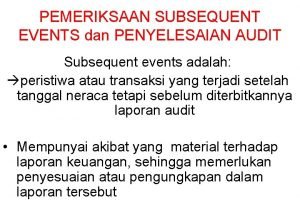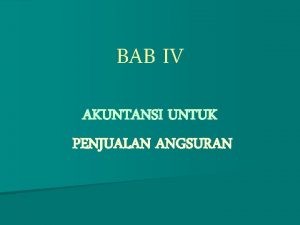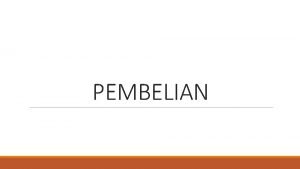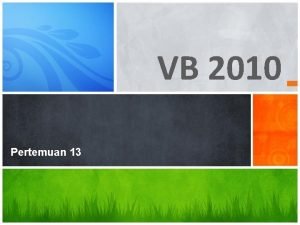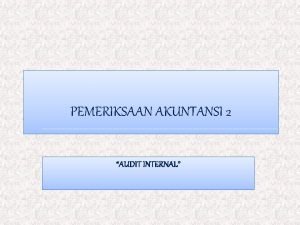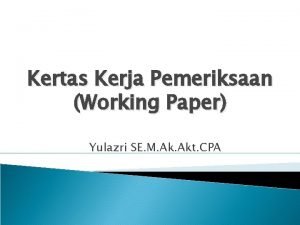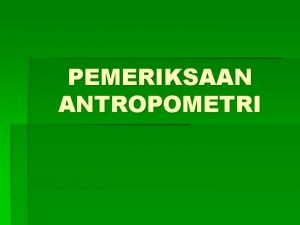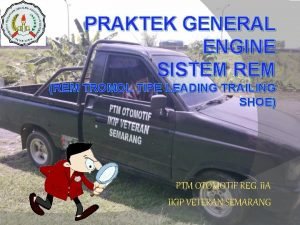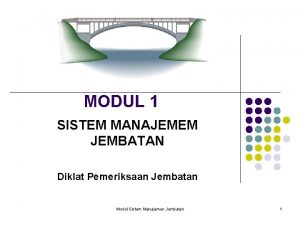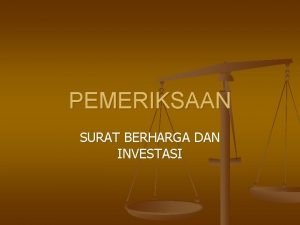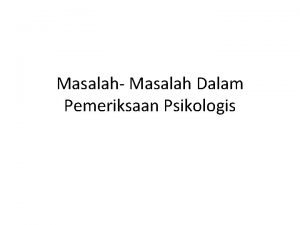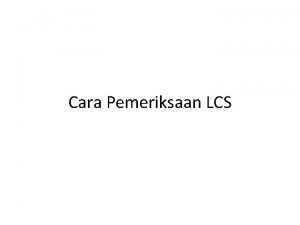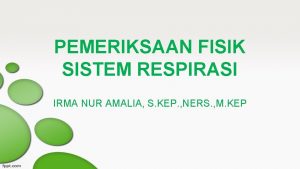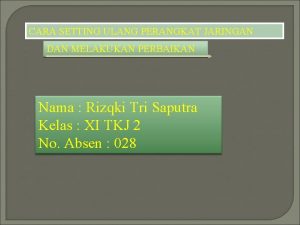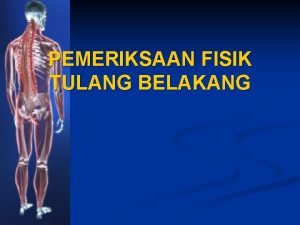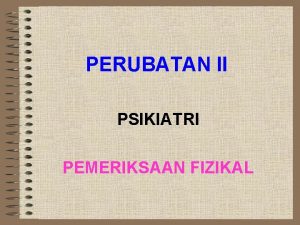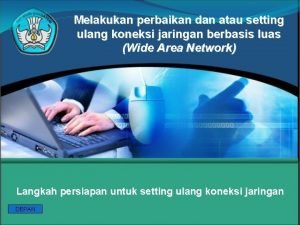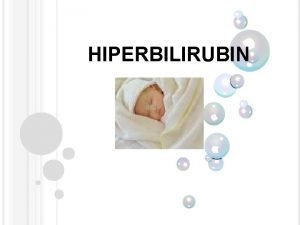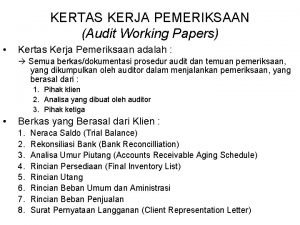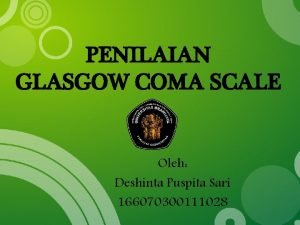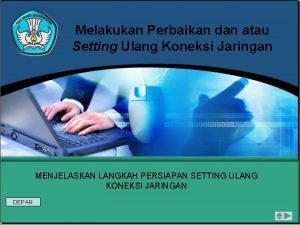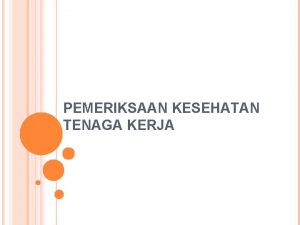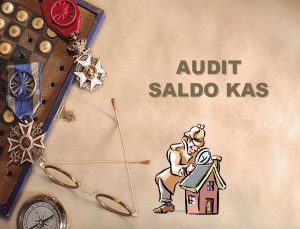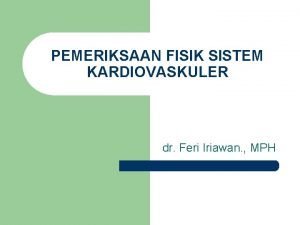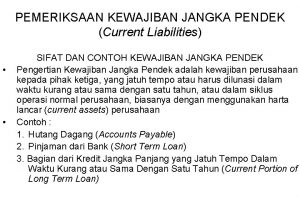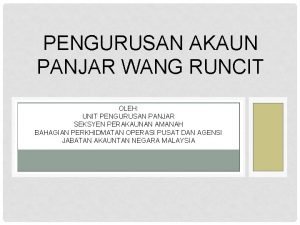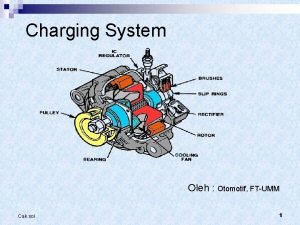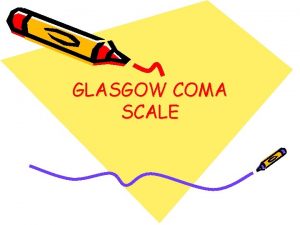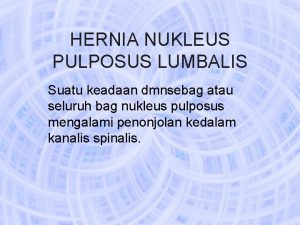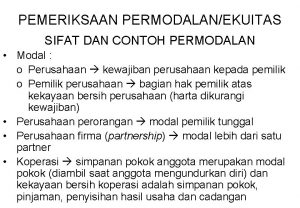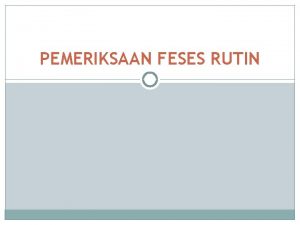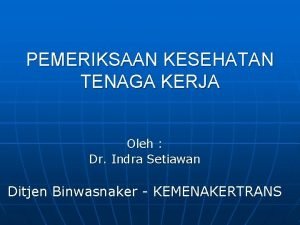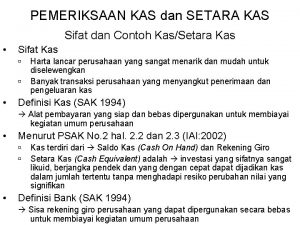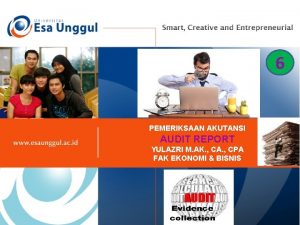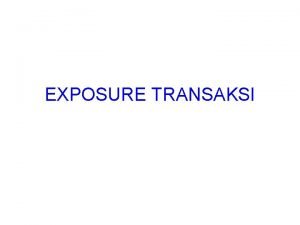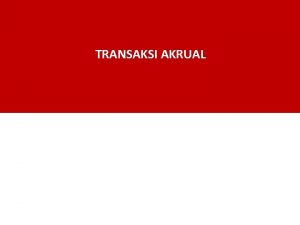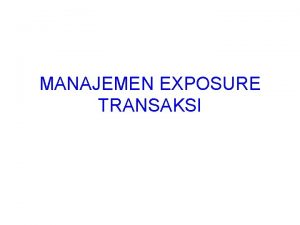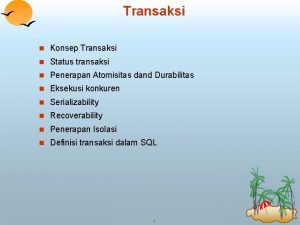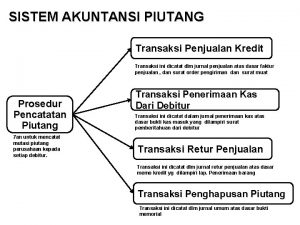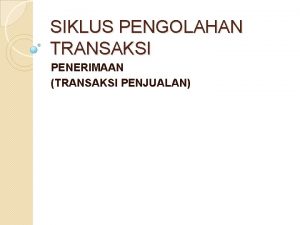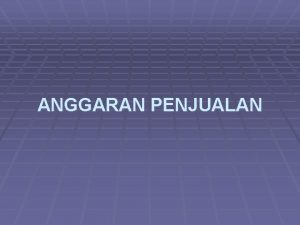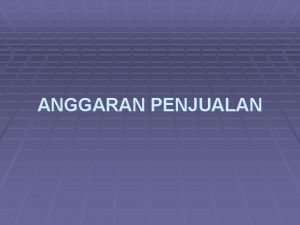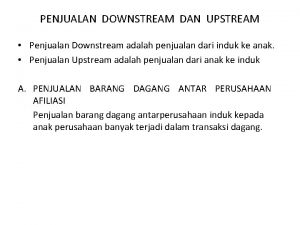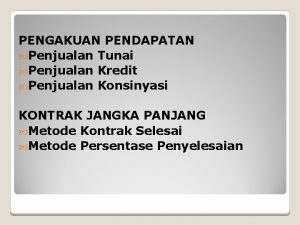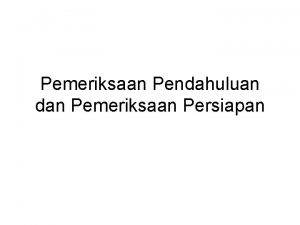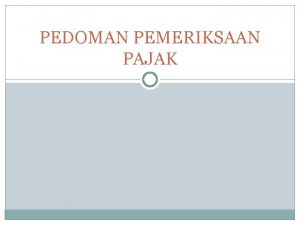PEMERIKSAAN AKUTANSI II TRANSAKSI PENJUALAN YULAZRI M AK


















































- Slides: 50

PEMERIKSAAN AKUTANSI II TRANSAKSI PENJUALAN YULAZRI M. AK. , CA. , CPA FAK EKONOMI & BISNIS © 2003 Prentice Hall Business Publishing, Essentials of Auditing 1/e, Arens/Elder/Beasley 11 - 1

VISI DAN MISI UNIVERSITAS ESA UNGGUL

Materi Sebelum UTS 01. JENIS TRANSAKSI 02. AUDIT PENJUALAN 03. AUDIT PIUTANG 04. KAS DANSETARA KAS - BAGIAN I 05. KAS DAN SETARA KAS - BAGIAN II 06. AUDIT AKTIVA TETAP 07. LAPORAN KEUANGAN © 2003 Prentice Hall Business Publishing, Essentials of Auditing 1/e, Arens/Elder/Beasley 11 - 3

Materi Setelah UTS 08. AUDIT PEMBELIAN 09. AUDIT PERSEDIAAN 10. AUDIT HUTANG 11. AUDIT EQUITAS 12. AUDIT PAYROLL DAN BIAYA 13. AUDIT FRAUD 14. COMPLETING AUDIT © 2003 Prentice Hall Business Publishing, Essentials of Auditing 1/e, Arens/Elder/Beasley 11 - 4

KEMAMPUAN AKHIR YANG DIHARAPKAN Mahasiswa memahami Tujuan, konsep dan metode Pemeriksaan Akuntansi. Mahasiswa mampu mengembangkan dan melakukan Pemeriksaan Akuntansi dengan baik dan benar sesuai dengan proses-prosesnya.


Aturan main kelas/penilaian l l l Kehadiran 75% minimal Tugas Partisipasi kelas UTS UAS 20% 30% Alpa jika tidak hadir Ijin sakit, duka, tugas kantor, keluarga ada surat ijin (ijin liburan atau yang lainnya tidak diakui) Ijin dalam 1 semester dibatasi hanya 3 x pertemuan, 2 ijin 1 x sakit atau sebaliknya, ijin selanjutnya diakui sebagai alpa Pengantar Auditing rev Sept 2016 7

Audit of the Sales and Collection Cycle

Identify the accounts and the classes of transactions in the Financial Sttaments

Routin transaction Transaction Non routin transaction Accounting Estimate

Routin Transaction Sales, receivable and collection Purchase, payable and payment Payroll and payment

Non Routin Transaction Acquisition of assets Investment Loan

Accounting Estimate Valuation of assets Valuation of inventory Valuation of receivable Taxes and corporate income tax etc

The classes of transactions in the sales and collection cycle.

Identify the business functions and the related documents and records in the sales and collection cycle.

Business function in sales and collection Customer order Sales return Shipping goods Allowance Sales transaction Charge off uncollectible Cash receipts Bad Debt

Processing Customer Orders Customer Order: A request for merchandise by a customer Sales Order: A document describing the goods ordered by a customer

Shipping Goods This is the first point in the cycle where company assets are given up. Shipping document

Sales Transaction Accounts Sales Accounts receivable Business Functions Processing customer orders, Granting credit, Shipping goods, Billing customers and recording sales Sales invoice, Sales journal or listing, Sales Documents transaction file, Accounts receivable master and Records file and trial balance, Monthly statements

Cash Receipts Transaction Accounts Cash in bank (debits from cash receipts) Accounts receivable Business Functions Processing and recording cash receipts Remittance advise, Prelisting of cash receipts, Documents Cash receipts transaction file, and Records Cash receipts journal or listing

Sales Returns and Allowances Transaction Accounts Sales returns and allowances Accounts receivable Business Functions Processing and recording sales returns and allowances Documents Credit memo and Records Sales returns and allowances journal

Charge-off of Uncollectible Accounts Transaction Accounts receivable Allowance for uncollectible accounts Business Functions Charging off uncollectible accounts receivable Documents Uncollectible account authorization form and Records General journal

Bad Debt Expense Transaction Accounts Bad debt expense Allowance for uncollectible accounts Business Functions Providing for bad debts Documents General journal and Records

Identify the accounts and the classes of transactions in the sales and collection cycle.

Cash/bank ACC Receivable Sales return Allowance for Bad debt expense

Accounts in the Sales and Collection Cycle Sales Cash sales Sales on account Cash in Bank Accounts Receivable Beginning Cash receipts balance Sales returns Sales on and allowances account Charge-off of Ending uncollectible balance accounts Cash Discounts Taken Sales Returns and Allowances Bad Debt Expense

Accounts in the Sales and Collection Cycle Accounts Receivable Beginning Cash receipts balance Sales returns Sales on and allowances account Charge-off of Ending uncollectible balance accounts Allowance for Uncollectible Accounts Charge-off of Beginning uncollectible balance accounts Estimate of bad debt expense Ending balance Bad Debt Expense

Understand internal control and design and perform tests of controls and substantive tests of transactions for sales.

Understanding Internal Control – Sales Study the client’s flowcharts, prepare an internal control questionnaire, and perform walk-through tests of sales.

Methodology for Designing Controls and Substantive Tests: Sales Understand internal control – sales Assess planned control risk – sales Evaluate cost-benefit of testing controls. Design tests of controls and substantive tests of transactions for sales to meet transactionrelated audit objectives. Audit procedures Sample size Items to select Timing

Assess Planned Control Risk – Sales Adequate separation of duties Adequate documents and records Monthly statements Proper authorization Prenumbered documents Internal verification procedures

Internal Verification Procedures Evaluate cost-benefit of testing controls. Design tests of controls for sales.

Transaction-Related Audit Objectives for Sales Existence: Recorded sales are for shipments actually made. Completeness: Existing sales transactions are recorded. Accuracy: Recorded sales are for the amount shipped.

Design Substantive Tests of Transactions for Sales Classification: Sales transactions are properly classified. Timing: Sales are recorded on the correct dates. Posting and summarization: Sales transactions are properly included in the accounts receivable master file.

Direction of Tests for Sales Customer order Shipping document Duplicate sales invoice Completeness Start Sales journal Existence Start General ledger = Accounts receivable master file

Summary of Methodology for Sales Column 1: Transaction-related audit objectives Column 2: Key internal controls Column 3: Test of controls Column 4: Weaknesses Column 5: Substantive tests of transactions

Learning Objective 5 Apply the methodology for controls over sales transactions to controls over sales returns and allowances.

Sales Returns and Allowances The transaction-related audit objectives and client’s methods of controlling misstatements are essentially the same for processing credit memos as those described for sales.

Sales Returns and Allowances There are, however, two important differences. Materiality Emphasis on objectives

Understand internal control, and design and perform tests of controls and substantive tests of transactions for cash receipts.

Tests of Transactions for Cash Receipts Determine whether cash received was recorded v Prepare proof of cash receipts v Test to discover lapping of accounts receivable v

Apply the methodology for controls over the sales and collection cycle to write-offs of uncollectible accounts receivable.

Audit Tests for Uncollectible Accounts Existence of recorded write-offs is the most important transaction-related audit objective. What is a major concern in testing accounts charged off as uncollectible? – covering up a defalcation by charging off accounts receivable that have been collected

Additional Internal Controls Over Account Balances Realizable value Rights and obligations Presentation and disclosure

Effect of Results of Controls and Substantive Tests of Transactions The parts of the audit most affected by the tests for the sales and collection cycle are: Accounts receivable Bad debt expense Cash Allowance for doubtful accounts

Role of all Audit Tests in the Sales and Collection Cycle Sales transactions Accounts Receivable Audited by TOC, STOT, and AP Ending balance Cash receipts transactions Cash in Bank Audited by TOC, STOT, and AP Ending balance Audited by AP and TDP TOC + STOT + AP + TDP = Sufficient competent evidence per GAAS

Understand how e-commerce activities affect the sales and collection cycle.

Effect of E-Commerce on the Sales and Collection Cycle The Internet and other developing technologies allow companies to develop new business models.

Effect of E-Commerce on the Sales and Collection Cycle Business-to-business (B 2 B) Business-to-consumer (B 2 C) Management’s assertions for sales and collection activities remain the same.

Effect of E-Commerce on the Sales and Collection Cycle Auditors should obtain an understanding of the design and operation of key internal controls over e-commerce revenues. Evidence for e-commerce activities is likely to be in electronic form.
 Pemeriksaan subsequent events dan penyelesaian pemeriksaan
Pemeriksaan subsequent events dan penyelesaian pemeriksaan Pertanyaan tentang penjualan angsuran
Pertanyaan tentang penjualan angsuran Potongan tunai
Potongan tunai Form transaksi penjualan
Form transaksi penjualan Pemeriksaan kepala dan leher
Pemeriksaan kepala dan leher Pemeriksaan akuntansi 2
Pemeriksaan akuntansi 2 Prosedur persiapan pemeriksaan penunjang
Prosedur persiapan pemeriksaan penunjang Pengertian kertas kerja pemeriksaan
Pengertian kertas kerja pemeriksaan Pemeriksaan antropometri adalah
Pemeriksaan antropometri adalah Standar minimal pelapis sepatu rem pada rem tromol adalah
Standar minimal pelapis sepatu rem pada rem tromol adalah Maksud panjar
Maksud panjar Pedoman pemeriksaan jembatan
Pedoman pemeriksaan jembatan Kresendi
Kresendi Tujuan pemeriksaan surat berharga dan investasi
Tujuan pemeriksaan surat berharga dan investasi Masalah dalam pemeriksaan psikologis
Masalah dalam pemeriksaan psikologis Bentuk selaput dara itu letaknya dimana
Bentuk selaput dara itu letaknya dimana Pemeriksaan lcs
Pemeriksaan lcs Etika dalam pemeriksaan psikologis
Etika dalam pemeriksaan psikologis Bengkak di leher kiri
Bengkak di leher kiri Reconfigure network
Reconfigure network Pemeriksaan fisik tulang belakang
Pemeriksaan fisik tulang belakang Trias meniere disease
Trias meniere disease Pemeriksaan perubatan penuh
Pemeriksaan perubatan penuh Bagaimana pemeriksaan ulang konfigurasi jaringan
Bagaimana pemeriksaan ulang konfigurasi jaringan Konsep matching cost against revenue
Konsep matching cost against revenue Ikterus adalah
Ikterus adalah Contoh kertas kerja pemeriksaan
Contoh kertas kerja pemeriksaan Gcs somnolen
Gcs somnolen Jelaskan tentang proses setting ulang jaringan
Jelaskan tentang proses setting ulang jaringan Pemeriksaan fisik head to toe
Pemeriksaan fisik head to toe Konvergen dan divergen dalam leopold
Konvergen dan divergen dalam leopold Uji presipitasi adalah
Uji presipitasi adalah Tujuan pemeriksaan surat berharga
Tujuan pemeriksaan surat berharga Dr syarif indra sps
Dr syarif indra sps Fungsi pulsation damper
Fungsi pulsation damper Pemeriksaan fisik sistem reproduksi
Pemeriksaan fisik sistem reproduksi Tujuan pemeriksaan kesehatan berkala
Tujuan pemeriksaan kesehatan berkala Akun imprest adalah
Akun imprest adalah Pemeriksaan fisik sistem kardiovaskuler
Pemeriksaan fisik sistem kardiovaskuler Pengkajian sistem imun
Pengkajian sistem imun Sifat liabilitas jangka pendek
Sifat liabilitas jangka pendek Panjar wang runcit
Panjar wang runcit Komponen alternator
Komponen alternator Skor gcs
Skor gcs Bragard sicard
Bragard sicard Contoh permodalan
Contoh permodalan Pemeriksaan bilirubin urine metode harrison
Pemeriksaan bilirubin urine metode harrison Apa itu fomema
Apa itu fomema Pemeriksaan sterkobilin feses
Pemeriksaan sterkobilin feses Pemeriksaan purna bakti
Pemeriksaan purna bakti Contoh kas setara kas
Contoh kas setara kas
